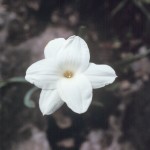Prairie Lily, Prairie Rain-Lily
Cooperia pedunculata
Liliaceae (Lily family)
Description
Prairie Rain-Lily grows from a black underground bulb up to about 1.5 inches or 4 cm tall, conical when young and becoming flattened to round. It spreads by bulb offsets and seeds, forming colonies. The linear leaves are blue-green, slender (up to one cm), grass-like, and basal, becoming narrower toward the end and may be up to 14 inches or 30 cm long depending on rainfall and soil moisture. Each leaf ends with dry, desiccated material. A flower stalk can reach 13 to 23 cm high with a single white bloom up to 2 inches across appearing a few days after a rain. The plant may or may not have leaves when the flower appears. Prairie Rain-Lily tends to be a spring bloomer with its flowers opening in the evening and only lasting a day. Its sweet-scented blooms are three petals and three sepals, all white, about 3 cm long, and an abrupt small point at the apex. On page 1200 in Shinners and Mahler’s Flora of North Central Texas, it states that the bloom, “… [it has a] perianth with a broadly funnelform limb about ½ or more as long as the narrowly cylindrical basal tube.” They go on to state that the perianth tube itself measured from the base to where it begins to widen is short, less than 4 cm which helps distinguish it from the more fall-blooming Rain Lily, Cooperia drummondii.Habitat
Prairie Rain-Lily is found in east, central, and southwestern Texas. Depending upon the region, it may be found along streams, in valleys, on roadsides, in open woods, or on hillsides. It prefers full sun.Toxic Agent
The toxic agent of Prairie Rain-Lily has not been identified, but it is found only in the dead leaf tips of plants growing in a limited geographical area. Biological examinations of specimens throughout the range indicate that plants in and near DeWitt, Gonzales, and Caldwell counties are highly photodynamic while those from other areas have little or no photoactivity. Photosensitivity occurs primarily in the fall but also during late spring or summer, usually within 10 days after a rain. This suggests that some microbiological activity on the dead leaf material is responsible for the activity. Severe outbreaks of photosensitization occur when rain falls on many dead leaves.Signs of Livestock Ingestion
Prairie Lily causes primary photosensitization, and poisoning results in loss of production but usually not death. The clinical signs are those of sunburn and include: Photophobia (animals try to stay in shade); Sunburn of light-colored skin; Crusting and cracking of light-colored skin; Sloughing of skin. It can cause blindness in deer and black cattle. This plant most often affects cattle in areas where the plants have high photoactivity. Severe outbreaks have included white-tailed deer. Deer and black cattle may become blind, and their eyes may turn cloudy and blue.Management Strategies
Place affected animals in the shade and give them adequate feed and water. Give supplemental feed to calves nursing severely affected cows, as they are often not allowed access to painful udders. Most ranchers with large Prairie Lily populations in DeWitt County have only black cattle, which prevents the majority of problems in most years.Images
Plant Characteristics
Flower Color: Pink, White
Seed Type: Non-Encapsulated
Duration: Perennial
Stem Texture: Hairless/Smooth
Growth Habit: Forbs/Broadleaf
Leaf Shape
 : Simple with Pinnate or Parallel Venation
: Simple with Pinnate or Parallel Venation
Season: Cool
Distribution
 : 01 - Pineywoods, 02 - Gulf Prairies and Marshes, 03 - Post Oak Savannah, 04 - Blackland Prairies, 05 - Cross Timbers and Prairies, 06 - South Texas Plains, 07 - Edwards Plateau
: 01 - Pineywoods, 02 - Gulf Prairies and Marshes, 03 - Post Oak Savannah, 04 - Blackland Prairies, 05 - Cross Timbers and Prairies, 06 - South Texas Plains, 07 - Edwards Plateau
Distributions
Distribution refers to the ecological region in Texas that a plant has been found. You can also view a clickable map.
Book: Toxic Plants of Texas (B-6105)
Collection: Toxics, Wild Flowers
Livestock Affected: Cattle
Livestock Signs: Blindness, Photosensitization, Standing in Shade/Water





